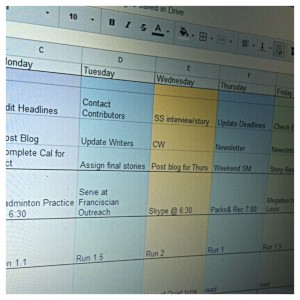With so much advice to take in, what really works?
By Jaclyn Crawford
With the amount of media coverage tailored to the topic, it seems everyone has a new trick to make life simpler and work faster. I enjoy being highly organized and  efficient, and am always open to learning a new way to make a task less complicated. If you look on my desk, for example, you will see a calendar outlining deadlines because I know the more windows I have open on my screen, the more likely I am to get off task. An old-fashioned pen and paper calendar allows me to look to my left and give someone an immediate answer.
efficient, and am always open to learning a new way to make a task less complicated. If you look on my desk, for example, you will see a calendar outlining deadlines because I know the more windows I have open on my screen, the more likely I am to get off task. An old-fashioned pen and paper calendar allows me to look to my left and give someone an immediate answer.
Every time that I read a new tip, though, I wonder if it really works. Some of the ideas seem obvious (e.g., write a to-do list or take a walk to reenergize), and some of them seem nonsensical (e.g., take a nap… that is the opposite of being productive). In light of the overwhelming amount of related information available today, I decided to put a few of the ideas I hadn’t encountered before to the test for two weeks, which is how long it takes to form a habit, according to well known research.
This blog post shares my experience with three different productivity tips.
1. Productive people get up extremely early.
Inspired by a FastCompany article:
This, for me, was the most challenging advice to put into action. I am not a morning person, and I am convinced I never will be. But, for the sake of Forefront and its readers, I set my alarm for 4:30 a.m. one day one, giving me four hours each morning before I need to catch my bus to work. When my alarm rang, I got up and got ready, enjoyed a cup of coffee on my porch—and soon realized it was 6:30 a.m. As comfortable as I was, I would have been much more comfortable with an extra two hours of sleep.
The next day, I adjusted my alarm clock to 45 minutes before I normally wake up. The next day, when my alarm rang, instead of running to get ready I simply poured my coffee and sat on my back porch for 30 minutes. Instinctively, my mind kept thinking that I needed to GO, GO, GO! But, I began to practice staying calm and relaxed, focusing on just the stillness of the day ahead. I have continued this for about two and a half weeks now.
While I do not disagree with what the orginal article from FastCompany said, I do not think getting up “insanely early” is the key. The trick is to get up with enough time so as not to have to rush to get going, instead focusing on easing oneself into the day. That did wonders for my workday. I came to work and was able to prioritize with a clear head and tackle my responsibilities at a better pace. Add a few minutes more to your morning, and it could make a significant difference in your overall day.
2. Keep track of what time you spend on what tasks.
As inspired by various sources, including this Forbes article
I LOVE LISTS AND PLANNING. At home, we have weekly dinners planned out up to three weeks in advance, and at work, I have to-do lists and calendars for each individual project. It works for me. So this tip seemed like a no-brainer: Of course it would work for me, I thought. I soon found out, however, that I was quite wrong.
Let’s look at a sample from July 23, 2013:
9:00 a.m. – 9:45 a.m.: Email/Zoho/Social Media
9:45 a.m. – 11:00 a.m.: Plan Social Media
11:00 a.m. – …
For about a week and a half, that is how my “time-tracking calendar” looked. And to be honest, what I said I got done was never actually what I really got done. When I was working on social media efforts, I also was juggling emailing and taking care of other things that came up. This method worked a bit better when I was working from home, but even then I never remembered to actually write down my time allotted to each task because I was already moving on to the next one.
I understand how and why this tip would work: It shows how one spends their day and what was accomplished. I think in certain positions, this would work well. But if you are in a position in which you juggle multiple responsibilities at any given time, I would suggest making a weekly project to-do list to better realize your goals by the end of the week.
3. The “WFPF” List or the “WPFP” List.
As inspired by a FastCompany article:
Let me preface this by saying that this tip is probably my favorite productivity tip of all time. That is a big statement, I know, but after three weeks of using this, it really has helped me stay on track with goals and simplified my planning. I will explain…
The WPFP list described in the aforementioned article stands for “Work, Play, Fit, Push,” and it is a chart that shows your whole week and your top priorities. I have changed the final ‘P’ to ‘F’ for “Faith” because, personally, carving out time for that is more important, so feel free to adjust the letters and priorities around to fit your life. I started my first chart on a Wednesday, and it was easy to keep track of my priorities through the week. For most weeks, I am able to accomplish everything on my list and by Friday I feel great about what I have done.
Here is why this works: It is simple and requires no extra effort. I set my calendar up on Monday, once I know the important tasks for the workweek ahead. The tasks on the list are clearly mapped out, so it is not overwhelming to remember what you would like to accomplish each day and there is no room to overwhelm yourself even if you wanted to. This list gives structure and boundaries to really have a successful and productive day.
These are my thoughts after making a concerted effort to put some get-efficient advice into action. What has been your experience with these or other methods? What methods do you live by?

